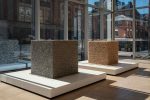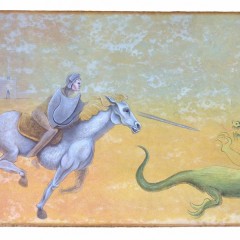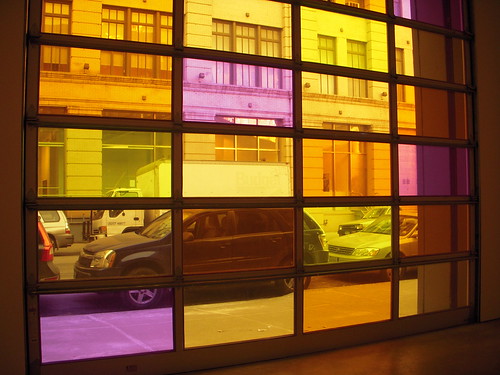
Spencer Finch does Jorge Pardo in the gallery front window at James Cohan Gallery (see way below). Beautiful or ugly? You decide.
Once again we went to hear Robert Storr at the Met last Saturday. (See previous post for Storr’s lecture on abstraction last week. ) We were looking for the light as usual but by the time the lecture ended we were confused as ever about the lecture’s point. In a lecture that ran at breakneck speed through a zillion slides with not a lot of commentary here’s what he said, more or less.
Beauty is a mutable concept the standards of which change through time. Jackson Pollock‘s paintings were regarded as ugly in their day…Beauty fell out of fashion when feminists questioned accepted standards in art — beauty based on the male gaze on female nudes. He defended unbeauty as a term because ugly is too limiting.
digression from Libby and Roberta–see NY Times magazine article about women’s sexuality. The male gaze has a genetic justification and so does the phenomenon of women dressing up and preeening. It’s hard-wired according to recent research.
Storr quoted Edmund Burke on how beauty and the sublime are not the same. Beauty is lesser; sublime is greater than us…overwhelming and threatening.
Beauty is proportionate, orderly, follows rules and is conservative. Storr said beauty becomes wearisome after a while. He kept referring to the beauty brigade and the beauty sweepstakes winners. We think he was talking about painters and critics and apologists for beauty without content. His argument seemed to suggest that beauty needs content, needs unbeauty and needs threat to keep us interested long term.
“At no time are we mindless, as the beauty brigade would have us be,” he said.

Our own idea of a beauty brigade, which we saw on Tenth Avenue, a site specific project by the NYC Department of Streets or Transportation or something. Beautiful or ugly? You decide.
Da Vinci used to follow deformed people and draw them. Beauty and unbeauty need each other to stake out their turf. Yadda yadda yadda.
We saw slides of the following artists:
Jackson Pollock, late de Kooning (which he thinks is beautiful); Frankenthaler (who he slapped down as merely beautiful and derivative); Morris Louis (Storr says he’s back “in”); Brice Marden, Terry Winters and Howard Hodgkin (winners of the beauty sweepstakes but short on concept);
Some people who he loves for their ugly-beautiness (He ran breakneck through slides of all these artists — and more — and we left unclear what the argument was): Carroll Dunham , Elizabeth Murray, Mike Kelley, Sigmar Polke, Bruce Pearson, Karen Leydon (sp?) Ellen Gallagher, Fred Tomaselli, Sylvia Plimack Mangold, Rackstraw Downs, Gerhard Richter, some Lucien Freud (the Leigh Bowery ones. “He’s an excellent painter but uneven (he experiments alot). zhe’s interested in psychology but less so than people think), Philip Pearlstein (he’s back in favor). William Bailey (Storr said Bailey invents all those still lifes!) , Lisa Yuskavage, John Currin, Eric Fischl (bad boy painting), Cindy Sherman, Francis Bacon (in again — people are looking at him with new eyes), Louise Bourgeois, Kiki Smith, Jenny Saville, Ann Hamilton, Martin Puryear, Tom Friedman, Franz West, Jeff Koons, Andy Warhol (beauty becomes too much), Felix Gonzales-Torres.
Chelsea
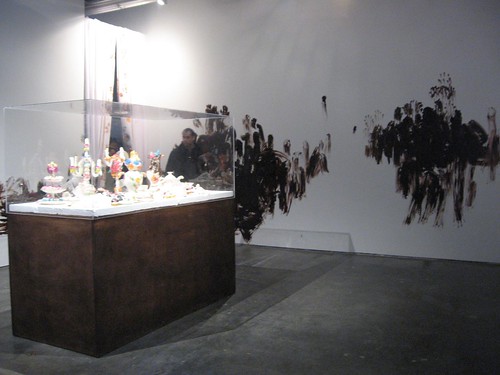
Nathalie Djurberg at Zach Feuer, installation shot
The lecture was preceded by untold beauty and juice — and a helluva lotta works on mylar — in Chelsea. About that, we wonder is mylar biodegradable? If not, why are y’all working in it? This ought to be the age of paper.
And, we found a new (to us) aboveground tunnel that runs between 11th and the river between 27th and 28th so we stayed warm for that block. The real highlight was the art we saw, especially the (now closed) Nathalie Djurberg claymation video at Zach Feuer. This is an artist who is very young but she’s not afraid to wade into the world of race relations and female body issues. If we’re talking beauty this is the kind of beauty we love. (Although he didn’t mention her, Djurberg fits Storr’s definition of beauty fraught with contradictions. We’ll take her over Lisa Yuskavage and John Currin any day.)
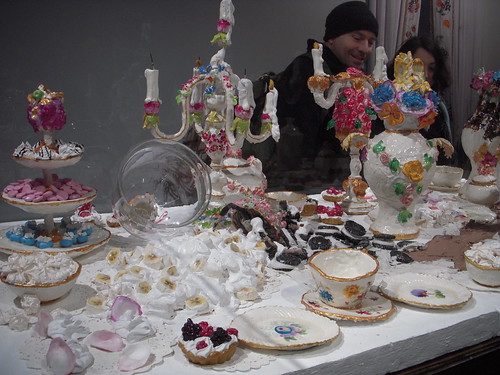
Nathalie Djurberg at Zach Feuer.
Djurberg, who we’ve seen and loved in group shows at ICA and the New Museum (links below) is about identity politics and politics. I found myself alone (2008) shows a dark-skinned ballerina twirling in a white world of confections and crockers, all white but for her. Over time she is overwhelmed– although not before she gets a little of her color smeared on things–and is frosted over by the oreo filling, dripping candles and frosting. A haunting, music-box-like soundtrack by Djurberg’s boyfriend Hans Berg perfectly sets the tone–one of sadness and beauty.
Djurberg also had another piece in her show, Of course I am working with magic, 2007
a stop-action animation made with charcoal on paper in the mode of William Kentridge. The subject — like her piece at the New Museum — pits nature against woman and woman against herself in an open-ended drama involving magic and witchery in a fairy tale forest far from Middle Earth.
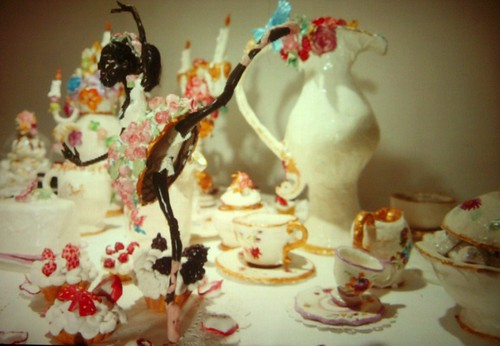
Natalie Djurberg, Swedish-born 30-something artist.
I found myself alone, 2008
Clay animation, digital video
9:45
Edition of 4
Music by Hans Berg
Posts on Djurberg in After Nature at the New Museum and the Puppet Show at ICA. Andrea just saw her in a show in Dublin
I Love BeNeLux

Roberta and Cate check out the pendulous kaleidoscopes in a show of art from Belgium, the Netherlands and Luxembourg
We also pursued the artists of Northern Europe in the show, I love Benelux at Virgil de Voldere Gallery. We met Virgil, too, and he recognized Cate who had been his teacher in a computer graphics course years ago at NYU. Amazingness! She remembered his project.
We loved the show which he had invited Italian-born, Amsterdam based artist Nina Bovasso to curate. It was full of painting, clay sculpture and very Euro (ie unembarrassed nudity and a lack of coyness about issues of the body, sex and paint). We loved the directness of the paintings–most of which were narrative, unframed, and pinned to the walls. We especially love the mockumentary series by Frans van Tartwijk which seems to chronicle the lives of a cult of artists as they perform various arty farty things. This is surreal without being pretentious. That’s something.
Even the portraits feel different.
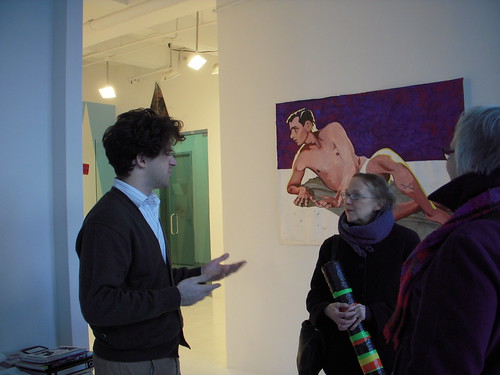
Virgil de Voldere, Cate and Libby in the gallery. We love Virgil’s hair…We now know two Virgils and Libby knows a Seneca.
The earthiness of the clay and the brut ad hoc making of the interactive kaleidoscopes are friendly and accessible and fun. And it’s got the ugly thing going on and some existential angst that’s right in tune with what everyone’s making all over the world. In general, the show has no self-conscious bones in its bodies and no post-modern posturing. This is one of the better group shows we’ve seen in a gallery lately.
Virgil told us that J Shih Chieh Huang, one of our favorite artists, will be featured as one of the artists in his booth at Pulse Art Fair in March. J just finished a Smithsonian Artist Research fellowship where he studied underwater creatures. Can’t wait to see what comes of that. We’ve been following this artist since we saw his robot critters at Vox Populi back in early artblog days, in 2004.
Down the hall from the gallery we saw Dona Nelson’s work in a group show at Thomas Erben where half the Tyler campus had signed the guest book for the Tyler prof. Good show.
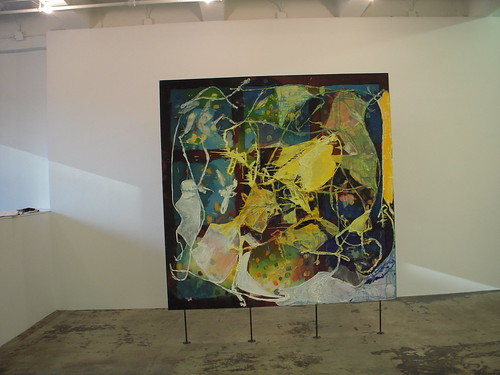
Dona Nelson at Thomas Erben Gallery
Michael Waugh

Michael Waugh, Plus Je Vois les Hommes, Plus J’admire les Chiens, 2008, detail, diptych, 28.5 x 22.5 unframed, ink on mylar
Every one loves a dog show and this show at Schroeder Romero is no exception. We loved it! Michael Waugh uses text from commission reports and embeds it in his ink on mylar drawings — or privileged pets cribbed from old master prints, drawings and paintings. He painstakingly transcribes the text — the text is his mark-making — into the image of the pampered pooches. It’s political work; it’s beautiful; it’s fun — like a puzzle. And the points he’s making are devastating: All these words have been written in pursuit of making the world a better place and none of the commission reports have really done the job. While we were there we saw a little commerce in action as a lady collector bargained over the price of a piece. (see the detail of the piece above)
.
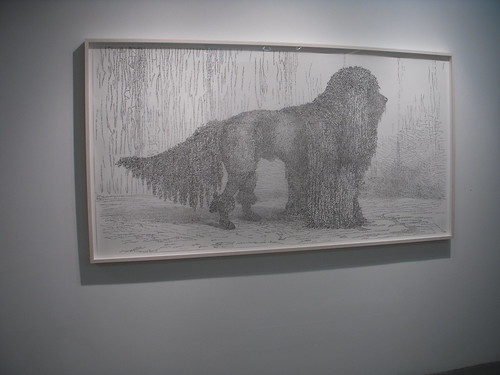
The Social Security Commission (part 1) Michael Waugh.
The show’s title, The more I see of men, comes from this quote: “The more I see of men, the more I admire dogs.” Jeanne-Marie Roland 1754-1793
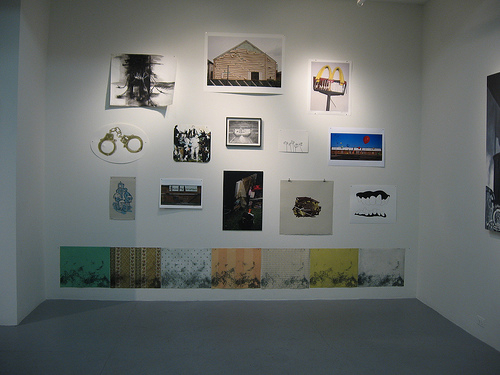
At Winkleman, Works from Paul Chan + The Front, including by (left to right, top to bottom) Jennifer Odem, Jonathan Traviesa, Michelle Levine, Stephanie Patton, Rachel Jones, Paul Chan, Megan Roniger, Andrea Ferguson, Claire Rau, Morgana King, Jeff Rinehart + Natalie Sciortino, Kyle Bravo, Julie Pieri and Jenny LeBlanc. part of show curated by Joy Garnett. These works all refer to the Ninth Ward in NOLA post Katrina.
Both Schroeder-Romero and Winkleman, next door, back onto the tunnel we told you about above. This month’s show at Winkleman, Things Fall Apart, is curated by Newsgrist’s Joy Garnett. The title suggests Chinua Achebe’s book by the same name, which describes a tribal culture falling apart amidst Africa’s urbanization. It also refers to William Butler Yeats’ apocalyptic The Second Coming–“Things fall apart; the centre cannot hold.” This show is about everything falling apart, from nature to buildings to relationships to American government (in its lack of response to Hurricane Katrina) to the world. It’s a very ambitious show that included a panel discussion with Paul Chan and his posse from New Orleans, the artist collective The Front.
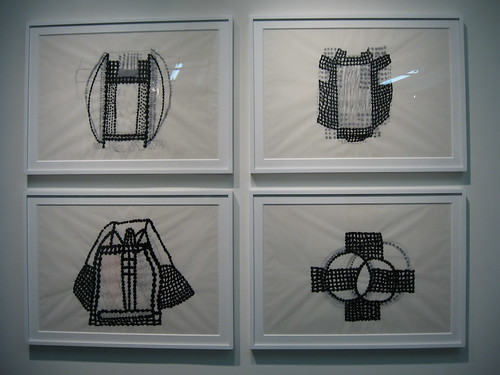
Susan Hefuna, from the Building Series, each 21 x 27 inches framed, ink on tracing paper, courtesy of Albion, New York
There was nice work in the show, including Garnett’s own two river paintings about the Three Gorges Dam. A couple of the photos of the decaying New Orleans are quite poignant. Much of the work was about buildings. Among the strongest and most unique were Susan Hefuna’s works from the Building Series, non-rectilinear and abstract renderings of Islamic lattice-work window screens. They have an endearing knitted quality.
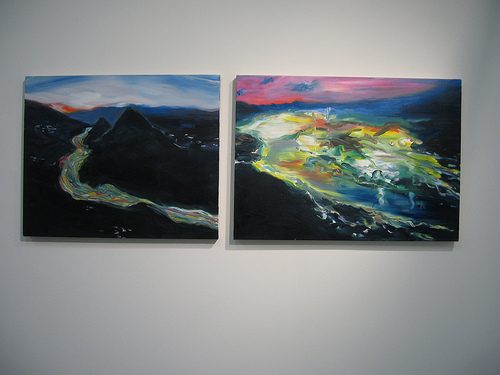
From Joy Garnett to Ode to Joy
Sun Jun performs Ode to Joy in Allora & Calzadilla’s piece at Gladstone
Speaking of politics and Joy and things falling apart, Allora & Calzadilla’s Stop, Repair, Prepare performance at Gladstone is a quick hit of alternative music when we least expected it. We were not alone–the gallery was full of people who stopped to listen to Sun Jun performing a variaation on Beethoven’s Ode to Joy in a specially hollowed-out piano. Originally executed in Munich — where it must have had great reverberations with the recent and not so recent history — the piece reverberated literally as well as figuratively. We love that the piano “walked” through the gallery. Apart from the politics the piece has great visual and aural power. Jun is one of a team from all around the world who will perform the piece. See the website for more.
Space Shapers
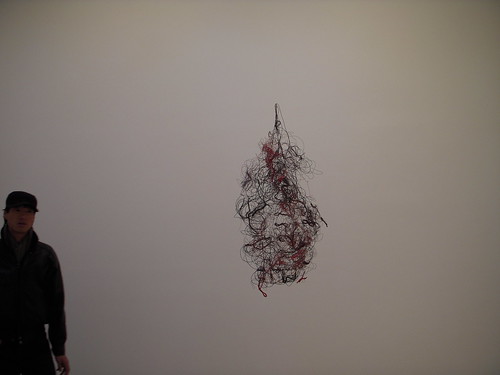
Alan Saret, evoking Eva Hesse’s tangles.
We were impressed by the museum-quality group show, Shaping Space, at James Cohan a sculpture show with a lot of rocks and clouds in it plus a lot of architecture by big names from Richard Long to Tara Donovan. The show is a roundup of major artists but it’s smaller than the sum of its parts–mostly the works don’t talk to each other. The siting or placement of works undermined the discussion between works. Alan Saret is big in this show although he’s new to us. Apparently his post-minimal work was big in the 1960s but then he dropped out. Here he is again in work that is a little bit Eva Hesse and very much a counterpoint to Fred Sandback’s straight-string drawings. Sandback is also in the show.
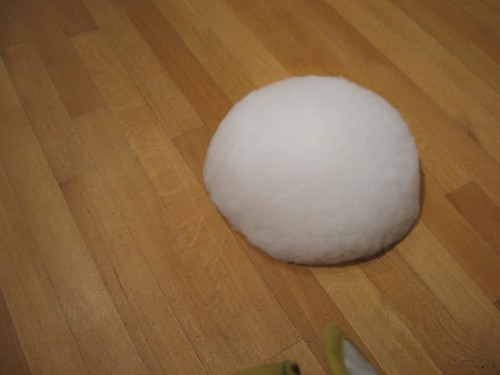
Tom Friedman, Cloud, pillow stuffing, at James Cohan, reminds us of Mike Stifel’s soap bubble rocks/clouds at FLUXspace last year.

Mike Stifel, Strange Attraction, at FLUXspace
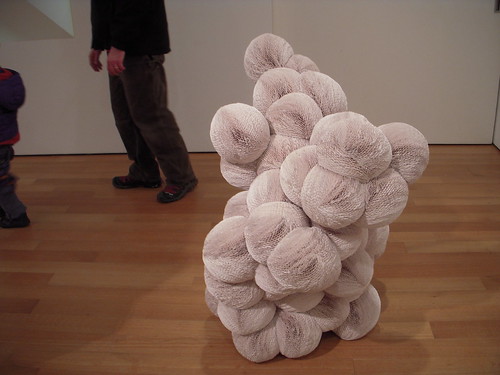
Tara Donovan–how to look great with paper plates and glue.



